Description
Contra-flow bicycle lanes are bicycle lanes designed to allow bicyclists to ride in the opposite direction of motor vehicle traffic. They convert a one-way traffic street into a two-way street: one direction for motor vehicles and bikes, and the other for bikes only. Contra-flow lanes are separated with yellow center lane striping. Combining both direction bicycle travel on one side of the street to accommodate contra-flow movement results in a two-way cycle track.
The contra-flow design introduces new design challenges and may introduce additional conflict points as motorists may not expect on-coming bicyclists.
Click on the images below to view 3D concepts of contra-flow bicycle lanes. The configuration shown is based on a Seattle, WA, example.
Treatment details can be accessed below under design guidance.
Contra-Flow Bike Lane Benefits
- Provides connectivity and access to bicyclists traveling in both directions.
- Reduces dangerous wrong-way riding.
- Decreases sidewalk riding.
- Influences motorist choice of routes without limiting bicycle traffic.
- Decreases trip distance, the number of intersections encountered, and travel times for bicyclists by eliminating out-of-direction travel.
- Allows bicyclists to use safer, less trafficked streets.
Typical Applications
- On streets where large numbers of bicyclists are already riding the wrong way.
- On corridors where alternate routes require excessive out-of-direction travel.
- On corridors where alternate routes include unsafe or uncomfortable streets with high traffic volumes and/or no bicycle facilities.
- On corridors where the contra-flow lane provides direct access to destinations on the street under consideration.
- Where two-way connections between bicycle facilities are needed along one-way streets.
- Works best on low-speed, low volume streets, unless buffer separation or physical protection is provided.
Design Guidance

Guidance for conventional bicycle lanes may also apply.
| Required Features |
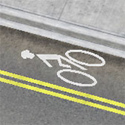 |
Bicycle lane word, symbol, and arrow markings (MUTCD Figure 9C-3) shall be used to define the bike lane direction and designate that portion of the street for preferential use by bicyclists. |
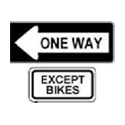 |
A “ONE WAY” sign (MTCD R6-1, R6-2) with “EXCEPT BIKES” plaque shall be posted along the facility and at intersecting streets, alleys, and driveways informing motorists to expect two-way traffic. |
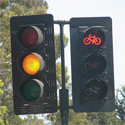 |
Intersection traffic controls along the street (e.g., stop signs and traffic signals) shall also be installed and oriented toward bicyclists in the contra-flow lane. |
| Recommended Features |
 |
A “DO NOT ENTER” sign (MUTCD R5-1) with “EXCEPT BIKES” plaque should be posted along the facility to only permit use by bicycles. |
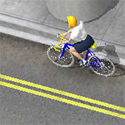 |
When configured without parking, a solid double yellow lane line marking should be used to separate opposing motor vehicle travel lanes from the contraflow bicycle lane. Read More+
Center line pavement markings, when used, shall be the pavement markings used to delineate the separation of traffic lanes that have opposite directions of travel on a roadway and shall be yellow (3B.01 01).
Two-direction no-passing zone markings consisting of two normal solid yellow lines where crossing the center line markings for passing is prohibited for traffic traveling in either direction (3B.01 04.C).
Federal Highway Administration. (2009). Manual on Uniform Traffic Control Devices.
|
 |
Consider a No Turn on Red restriction by installing a “No Turn on Red” sign (MUTCD R10-11) on cross streets to minimize potential conflicts with turning vehicles. Cross street traffic may not look for or anticipate contraflow bicycle travel. Read More+
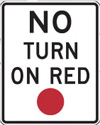 MUTCD R10-11, R10-11a, or R10-11b
|
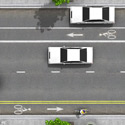 |
Where there is room, bike lanes should be used on both sides. When there is no room for a with-flow lane, shared lane markings should be used to guide with-flow bicyclists to keep to the right side of the road. Read More+
“Where there is room for bike lanes on both sides of the street, they should be included to clarify where bicyclists should travel. If there is no room for a full bike lane, other pavement markings or signs should be considered to clarify direction.”
Pedestrian and Bicycle Information Center. (2006). BIKESAFE: Bicycle Countermeasure Selection System. Publication No. FHWA-SA-05-006, Federal Highway Administration, Washington, DC.
|
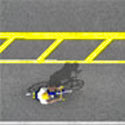 |
If sufficient space exists, a buffered bike lane design should be used. The buffer should conform with Figure 3D-4 of the MUTCD. A broken buffer may be used if on-street parking is present. |
 |
Contra-flow bike lane markings should be extended across the intersection, especially for contra-flow lanes against the curb, as a way of alerting cross street traffic to look for contra-flow bicyclists. |
| Optional Features |
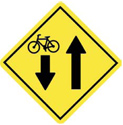 |
Warning signage, such as a modified “TWO WAY” sign (MUTCD W6-3) may be posted along the facility to inform motorists to expect two-way traffic. |
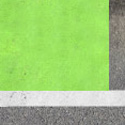 |
Colored pavement may be used along the facility to draw attention to the unique function of the lane, or in areas with cross traffic, such as at driveway exits, for increased visibility of bicyclists. |
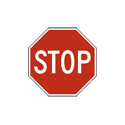 |
Small versions of “STOP” signs (18 x 18 inches) and other regulatory signage may be used along the contra-flow lane to emphasize that only bike traffic is permitted to travel in the contra-flow direction. |
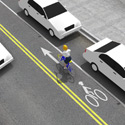 |
Special consideration should be given before implementing contra-flow bike lanes adjacent to parking. Cars entering and exiting the parking lane will be maneuvering head-on with oncoming bicyclists, introducing an increased speed differential and unfamiliar traffic operations. The driver of a vehicle parked adjacent to a contra-flow lane will have reduced visibility of oncoming bicyclists when compared to parking adjacent to a with-flow bike lane. Increased bike lane width paired with parking-side buffer striping may be used to increase maneuvering space and sight distance.Most existing installations use a double yellow line to separate the contra-flow bicycle lane, however local ordinance may prohibit parking in the opposite direction of the contra-flow travel lane. A dashed yellow line, or dashed white line may also used to separate the contra-flow bicycle lane. Local urban practitioners should use best engineering judgment to determine which strategy to implement. |
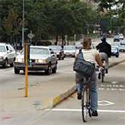 |
A curb or a raised median may be used in place of double yellow striping to separate the contra-flow lane from opposing vehicle traffic. Such a facility becomes a contra-flow protected cycle track. |
Maintenance
- Like all bicycle lanes, contra-flow bike lanes should be maintained to be free of potholes, broken glass, and other debris.
- If trenching is to be done in the bicycle lane, the entire bicycle lane should be trenched so that there is not an uneven surface or longitudinal joints.
- Please see guidance for conventional bike lanes.
Treatment Adoption and Professional Consensus
Contra-flow bike lanes are used in the following US cities:
- Austin, TX
- Boise, ID
- Boulder, CO
- Cambridge, MA
- Brookline, MA
- Baltimore, MD
- Chicago, IL
- Eugene, OR
|
- Madison, WI
- Minneapolis, MN
- New York City, NY
- Portland, OR
- San Francisco, CA
- Seattle, WA
- Washington, DC
|